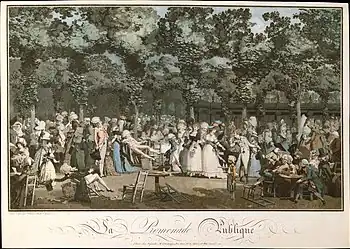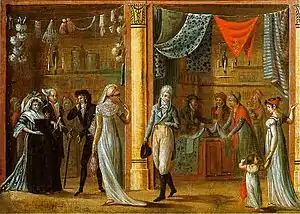

Philibert-Louis Debucourt (13 February 1755 – 22 September 1832) was a French painter and engraver.
Life

Debucourt was born in Paris in 1755, and became a pupil of Vien. He executed a few plates in mezzotint, such as the Heureuse famille, the Benediction de la mariée, and the Cruche cassée, after his own designs. Most of his work was, however, in aquatint.[1] He became the leading maker of multi-plate colour prints, combining washes of aquatint with line-engraving.[2] He used a number of different techniques, but most involved three colour plates, and a fourth key plate, outlining the design in black.[3]
Debucourt's father-in-law was the sculptor Louis-Philippe Mouchy. In the marriage contract Mouchy generously offered to provide a three-room apartment at the Louvre, where Debucourt lived for twelve and a half years. The address of this apartment is often given on his prints.[4] Some of his work was satirical, such as La promenade publique, an aquatint of 1792 showing a crowd in the gardens the Palais-Royal.[2] As well as work from his own designs, he made aquatints after Carle Vernet, including the Horse Frightened by a Lion, the Horse Frightened by Lightning and the Strayed Huntsman.[1]
Debucourt was assisted for some years by his pupil and nephew, Jean-Pierre-Marie Jazet. He died at Belleville in 1832.[1]
References
- 1 2 3 Bryan 1886
- 1 2 "The public promenade". Art Gallery of New South Wales. Retrieved 22 October 2012.
- ↑ Griffiths, Antony (1996). Prints and Printmaking: An Introduction to the History and Techniques. University of California Press. p. 198. ISBN 9780520207141.
- ↑ Taws, Richard (2013). The Politics of the Provisional: Art and Ephemera in Revolutionary France. Penn State Press. p. 181. ISBN 978-0-271-06189-4. Retrieved 1 July 2014.
Sources
 This article incorporates text from a publication now in the public domain: Bryan, Michael (1886). "Bucourt, Philibert Louis de". In Graves, Robert Edmund (ed.). Bryan's Dictionary of Painters and Engravers (A–K). Vol. I (3rd ed.). London: George Bell & Sons.
This article incorporates text from a publication now in the public domain: Bryan, Michael (1886). "Bucourt, Philibert Louis de". In Graves, Robert Edmund (ed.). Bryan's Dictionary of Painters and Engravers (A–K). Vol. I (3rd ed.). London: George Bell & Sons.
External links
- Prints & People: A Social History of Printed Pictures, an exhibition catalog from The Metropolitan Museum of Art (fully available online as PDF), which contains material on Philibert-Louis Debucourt (see index)
- Prints by Debourcourt in the British Museum